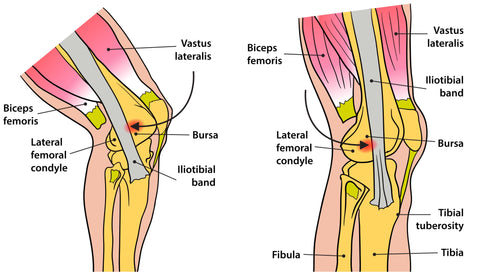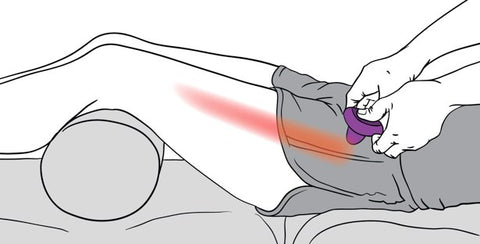Trigger Point Therapy - ITB Syndrome
ITB Syndrome - Taping is Often Applied Post Treatment to Provide an Off-Loading Effect
ITB Syndrome .... there are no "magic cures" but in most cases trigger point therapy can have profound effects
I've been fortunate to have been working with elite athletes for the past 20 years, including the provision of soft tissue support for the Australian Olympic teams at the last four Olympic games.
Together with my colleagues we've been faced with the need to treat 1000's of cases of ITB Syndrome, and whilst there's still much that we don't know about this injury, we have learned through trial and experience, that ITBS can be treated effectively with hands-on protocols.

What is ITB Syndrome?
The Iliotibial band syndrome has been a source of significant debate when it comes to its aetiology, pathology and treatment.
That is mainly because the iliotibial band itself is an intriguing mystery in sports medicine.
The IT band as it is commonly called is the area that runs along the outside our thigh - from above the hip to just below our knee.
The band is made up of fascia, a connective tissue that is elastic in nature and that is found throughout our body.
The IT band however is the largest piece of fascia in the human body.
It is still not clear whether the IT band evolved for running or walking but researchers do know that it stores more elastic energy during running than walking.
The basic theory is that it plays an important role in locomotion. As our limbs move, the IT band stretches accordingly.
When we move backward, energy is stored and as our leg swings forward, the energy is released. The concept is more or less similar to that of recycling energy.
What are the primary symptoms?
The two primary muscles involved in the IT band syndrome are the buttock muscle and the tensor fasciae latae muscles.
That is why the syndrome is also often referred to as the Tensor Fasciae Latae Syndrome.
The primary symptom of IT band syndrome is a sharp pain in the outer area of the knee. This pain can radiate into the outer thigh or calf.
In some cases, the pain can also spread onto the hip.
Most runners experience more pain going downhill and many experience symptoms only during the activities.
However, as the syndrome progresses, it occurs even when they walk.
Preventative Measures
Despite the fact that the IT band syndrome is very common among runners and cyclists, the underlying cause still remains unknown.
However, those who wish to pursue their running career without the complication of the IT band syndrome, there are some very simple preventive measures that can be undertaken.
These include the use of proper and supportive running shoes. Shoes should be changed at regular intervals since running shoes tend to lose half of their shock absorptive capacity after approximately 300 miles.
Thus, wearing the same shoe for too long increases the risk of ITBS and other injuries.
In addition, those who actively run and cycle should do strengthening exercises regularly to avoid IT band syndrome.
Finally, runners should avoid doing too much too soon. The volume of activity should not be increased by more than 5 to 10 percent per week.
If the individual wants to go for a longer run, he should do it at a slower pace so as to avoid the risk of injury.
The type of running surface can also play a role in increasing the likelihood of IT band syndrome.
The important thing to remember is that the earlier the syndrome is diagnosed and treated, the less are the chances of it becoming a chronic condition.
Since the cause of the syndrome remains unclear, runners should ensure they are following basic guidelines to ensure they do not overstretch or overuse the IT band.

ITB Syndrome - Treating Trigger Points can have profound effects
Trigger Point Therapy and ITBS
As with most injuries there is no miracle cure for ITB Syndrome, and we certainly don't yet know enough about the cause and effect of trigger points.
What we do know is that treating various trigger points in the TFL and Gluteus muscles in certain sequences often produces profound effects and may accelerate recovery beyond standard PT or sports massage protocols.
Because ITB Syndrome is so common with athletes (one study found it to be the most common injury of the lower extremity among college athletes who played basketball, field hockey and soccer), numerous techniques have evolved and become established as standard practice.
More often than not, these techniques involve the treatment of trigger points, at the very least as part of a broader treatment program.
About Stuart Hinds
Stuart Hinds is one of Australia's leading soft tissue therapists who recently (June 2016) received a lifetime achievement award from the Australian Massage Therapy Association. Stuart is a lecturer at Victoria University, Melbourne, on Soft Tissue Techniques, and has been part of the Australian Olympic manual therapy team for over 20 years (Sydney 2000, Athens 2004, Beijing 2008, London 2012).
Links
Find a Trigger Point Professional in your area
More Articles About ITB Syndrome
More Articles About Hip Injuries and Treatment
Online Hip Course - Stuart Hinds
Dry Needling for Trigger Points
Certify as a Trigger Point Therapist
About Niel Asher Education
Niel Asher Education (NAT Global Campus) is a globally recognised provider of high-quality professional learning for hands-on health and movement practitioners. Through an extensive catalogue of expert-led online courses, NAT delivers continuing education for massage therapists, supporting both newly qualified and highly experienced professionals with practical, clinically relevant training designed for real-world practice.
Beyond massage therapy, Niel Asher Education offers comprehensive continuing education for physical therapists, continuing education for athletic trainers, continuing education for chiropractors, and continuing education for rehabilitation professionals working across a wide range of clinical, sports, and wellness environments. Courses span manual therapy, movement, rehabilitation, pain management, integrative therapies, and practitioner self-care, with content presented by respected educators and clinicians from around the world.
Known for its high production values and practitioner-focused approach, Niel Asher Education emphasises clarity, practical application, and professional integrity. Its online learning model allows practitioners to study at their own pace while earning recognised certificates and maintaining ongoing professional development requirements, making continuing education accessible regardless of location or schedule.
Through partnerships with leading educational platforms and organisations worldwide, Niel Asher Education continues to expand access to trusted, high-quality continuing education for massage therapists, continuing education for physical therapists, continuing education for athletic trainers, continuing education for chiropractors, and continuing education for rehabilitation professionals, supporting lifelong learning and professional excellence across the global therapy community.

Continuing Professional Education
Looking for Massage Therapy CEUs, PT and ATC continuing education, chiropractic CE, or advanced manual therapy training? Explore our evidence-based online courses designed for hands-on professionals.


















